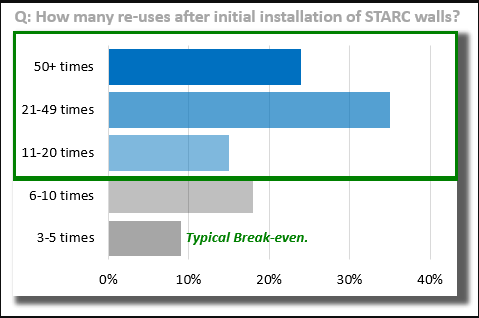
STARC’s impact to date? Over 160,000 cubic yards of single-use drywall waste saved… and counting
The construction industry is facing a reckoning: outdated building practices are trashing the planet—literally. But there’s a better way. Temporary wall systems are quietly leading a sustainability revolution, helping AEC pros build smarter, cleaner, and greener.
Transforming Construction: Temporary Walls
The growing adoption of reusable temporary construction walls is doing more than reducing mess on-site—it’s reshaping how the industry thinks about sustainability:
- Less waste, more savings: Traditional builds generate mountains of waste. STARC’s precision-designed, modular systems drastically reduce that. With panels reused dozens of times, it’s a no-brainer for budget-conscious and eco-minded teams.
- Smarter logistics: Forget hauling truckloads of drywall and debris. Our finished panels arrive ready to install, reducing carbon emissions and making logistics more sustainable.
- Walls with purpose: By keeping noise, dust, and debris locked in, STARC panels not only streamline clean-up—they protect the surrounding environment, creating safer, more productive job sites.
Reusability Unlocks Green Potential
STARC doesn’t just talk sustainability—we build it in.
According to the findings of a recent survey, nearly half of our customers have reused their original purchase 20 or more times. Seventy-four percent report using STARC panels 11 or more times.

100 linear feet of STARC walls re-used five times saves 9.3 cubic yards and 5 tons of landfill waste (1).
And we’re demonstrating leadership:
- Waste warrior: Over 160,000 cubic yards of single-use drywall waste avoided. That’s enough to fill more than 48 Olympic-sized swimming pools—waste that would otherwise end up in landfills.
- Carbon footprint slasher: STARC’s reusable wall systems have helped sidestep the creation of over 35,000 tons of CO₂ emissions in gypsum production for temporary containment.2 That’s the carbon equivalent of building 175 Statues of Liberty—and then deciding not to.
- Efficiency exemplar: 95% of customers reuse STARC panels immediately or return them for future use—proof that smart containment equals less waste and better ROI.
A Sustainable Future With Temporary Construction Walls
As the industry shifts toward more sustainable practices, we’re proud to help lead the charge. Our systems deliver on sustainability without sacrificing safety, speed, or aesthetics.
Ready to build greener? Contact us to learn how STARC temporary wall systems can help you achieve your environmental goals—without compromising performance.
Want a visual breakdown? Download the infographic.
Sources and methods.
(1) Linear feet and landfill impacts calculated from 2022 customer re-use survey and customer purchase history.
(2) EPA conversion factors applied to tonnage of drywall waste avoidance estimates.
(3) Average weight of an Ford F-150 is approximately 4,000 pounds, depending on the model and trim.
